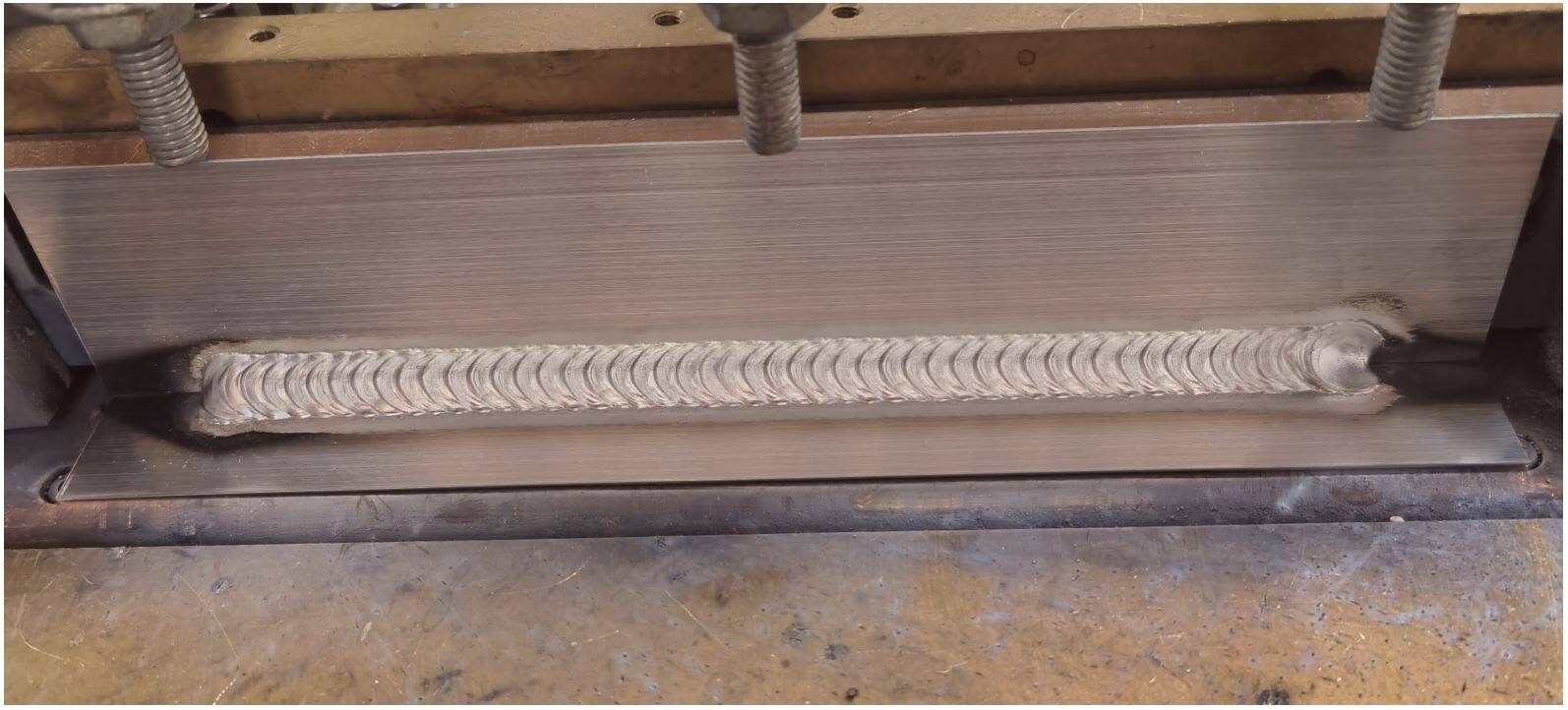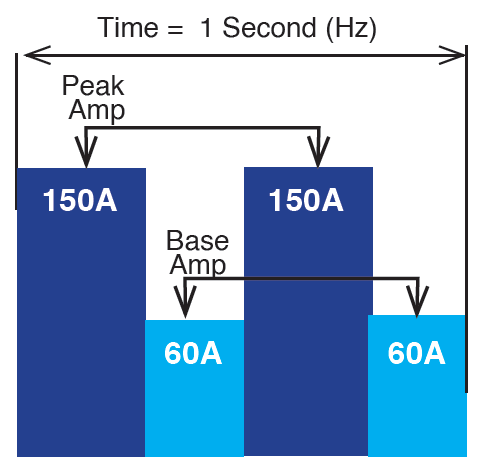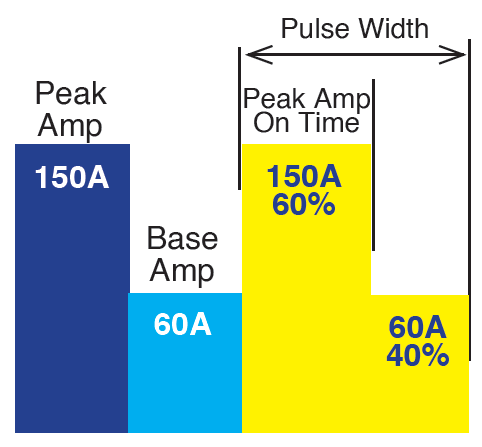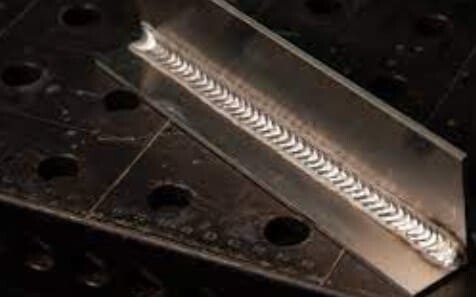Pulse welding is a specialized technique that alternates the amperage between a high point and a low point during the welding process. This method helps maintain a low overall heat input while still achieving proper penetration.

I. Key Parameters of Pulse Welding
Several settings can be adjusted in pulse welding to suit the specific requirements of your project:
1) Pulse Frequency/Pulse Hertz
Pulse frequency (or pulse hertz) refers to the number of pulses delivered per second. Typically, pulse frequencies can range from 0.5 to 200 Hz. This means that at 1 Hz, there is one pulse per second, while at 50 Hz, there are 50 pulses per second.
-
Slow Pulses: One pulse per second is relatively slow and easy to track visually.
-
Fast Pulses: 30 pulses or more per second are faster and can be difficult to perceive individually, making it challenging to time your weld accurately. Pulses between the 5-30 Hz range can be visually similar to strobe lights, which can be unpleasant and complicate focus.
Choosing the appropriate pulse frequency depends on the application. For welding thin materials, faster pulse rates are typically more effective and produce high-profile beads, while slower pulse rates are better for thicker materials, resulting in low-profile beads.

2) Pulse Percentage (%)
The pulse percentage defines how much time is spent on peak versus base amps within each pulse cycle. For example, setting the percentage to 50% means that half of the pulse cycle is spent at peak amps while the other half is at base amps.

II. Pulse Welding Techniques
1) TIG Pulse Welding
Pulse welding with TIG (Tungsten Inert Gas) is similar to standard TIG welding but requires a few additional machine adjustments. When pulse welding with TIG, you can feed the filler rod in two primary ways:
-
Dabbing: Depending on the pulse rate, you can dab the filler rod on the peak amps and pause during the base amps. At 1 pulse per second, this technique can be easily managed. However, at higher pulse rates (e.g., 50 Hz), maintaining consistent dab timing becomes challenging due to the rapid pace of the pulses.
-
Lay Method: In this technique, you keep the rod's tip at the leading edge of the puddle while dragging it down the weld, allowing it to melt into the weld seam.
Both methods can yield successful results; however, if you primarily use the lay method with high pulse settings, the aesthetic "stacked dimes" appearance might be less pronounced, although the weld remains strong.
You can also use your foot pedal during pulse welding. Holding it at full throttle maintains your peak amps, but you can adjust the peak amps downward without altering the base amps, effectively controlling the weld's heat as needed.
2) MIG Pulse Welding
MIG (Metal Inert Gas) pulse welding can be categorized into two types:
-
Single Pulse: This method alternates between peak and background currents, creating a spatter-free weld similar to TIG. The background current is not hot enough to transfer metal, but it sustains the arc, offering the benefits of spray transfer—speed and deep penetration—without excess heat.
-
Double Pulse: Double pulse welding adds a layer of sophistication by incorporating two pulses in one cycle. While the first pulse alternates between peak and base amps, the second pulse maintains the arc without transferring any wire, allowing the base material to cool slightly. For example, Megmeet Artsen II P(C)M series MIG/MAG Welders, integrate the control of MIG/MAG/C02 process, Pulse/Double Pulse MIG/MAG, are able to be used in multiple metal materials and produce high quality.

This technique promotes excellent weld aesthetics, creating a stacked-dime effect similar to TIG welding without requiring extra effort from the operator.
III. Benefits of Pulse Welding
-
Focused Arc: Pulse welding concentrates the arc, resulting in smaller bead sizes that are easier to control while ensuring full penetration.
-
Puddle Freezing: The cooling during the base amps allows for better puddle control, flattening the weld and enhancing its appearance.
-
Reduced Spatter: Pulse welding also minimizes spattering, resulting in less clean-up post-weld.
IV. When to Use Pulse Welding
-
Out-of-Position Welding: The cooling effect helps prevent dripping and maintains the weld where intended.
-
Thin Sheet Metal: The lower heat input reduces distortion, making pulse welding ideal for thin materials.
-
Variable Metal Thicknesses: Pulses aid in controlling the weld pool, especially when joining different thickness materials, such as in lap joints.
-
Materials with High Thermal Conductivity: Materials like stainless steel and aluminum benefit from pulsing due to reduced distortion while still achieving penetration.
-
Filling Holes: The cooler welding process allows for safer and more controlled filling of holes without the risk of blowing through the material.
V. Conclusion
While pulse welding is not the only approach for various welding tasks, it simplifies many challenging aspects, making it a valuable technique for welders. It requires some understanding of machine settings, but once mastered, it offers significant advantages concerning appearance, control, and efficiency. With the reduced heat input, enhanced penetration, and minimized spatter, pulse welding can be an excellent choice for a range of applications, from intricate sheet metal work to welding out-of-position joints.
VI. Final Thoughts
If you’re considering incorporating pulse welding techniques into your workflow, take the time to familiarize yourself with your machine’s settings. Experimenting with pulse frequency, pulse percentage, and understanding your welding environment will pave the way for achieving optimal results. Whether you gravitate towards single or double pulse techniques, the core principle remains the same: achieving better control over your weld while enhancing quality and reducing post-weld cleanup.
Related articles:
1. Pulse or No Pulse? When and Why You Should Pulse Weld?
2. Advantages of Utilizing Pulsed MIG Welding for Aluminum
3. Pulsed vs. CW Laser Welding: Key Differences | Expert Insights
4. MIG, Pulsed MIG, and Double Pulsed MIG Explained.
5. Quick Pulse: A Welding Technology More Suitable for Manual Welding






